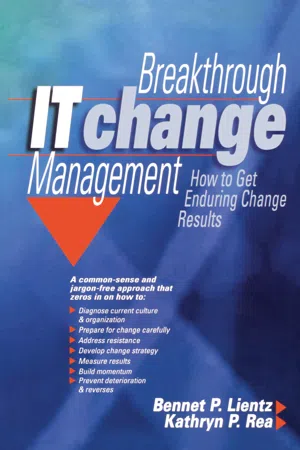
Breakthrough IT Change Management
Bennet Lientz,Kathryn Rea
- 311 pagine
- English
- ePUB (disponibile sull'app)
- Disponibile su iOS e Android
Breakthrough IT Change Management
Bennet Lientz,Kathryn Rea
Informazioni sul libro
This is a *different* book on change management. Using commonsense and practical advice tested in their work with hundreds of organizations, the authors walk the reader through clear guidelines and checklists to implement change that works.
Readers will develop a change management strategy
that starts by diagnosing the current culture and organization, then prepares for change carefully, addresses resistance to change, develops the change strategy, measures results, builds momentum for further change, and prevents deterioration and reversion.
The authors then apply their framework to two areas that are major targets for change management: implementing new technology and systems and implementing successful e-business strategies. Included throughout are real-world examples from a number of industries and government.
Domande frequenti
Informazioni
Part ISelect Your Change Management Strategy and Approach
Chapter 1Introduction
Background of Change
There is the fear of change and what might happen.There is the potential loss of power due to the change.There is the effort, sometimes, great to react to the change.
You cannot assume that change markets and sells itself.
If there are no guidelines as to what to do after the change, then there will be issues and problems.
Timing is critical for successful change.
When you successfully implement change, you cannot assume that it will continue. Processes and work are subjected to continuous pressure that can lead to reversion.
- A new type of work can arrive. People don't know what to do so they revert.
- New employees are brought in without proper training in the work so they employ what they knew from before—the methods for doing the work have just been subverted.
- Somebody comes up with some new idea and unplanned change occurs— maybe good or bad.
- Very few processes or work patterns are stable—there is always pressure and factors that challenge the current methods.
- The effects of change and the work must be measured on an ongoing basis to detect reversion and to look for further improvement.
- There must be something in the change for the employee or person doing the work—self-interest is critical in change.
- The change and new ways must be protected from new situations that arise that can pervert or cause stress to the new process.

Motivation and Triggers for Change

- Upper management, organization change, mergers
- Competition
- Regulation
- Customers/suppliers (change in the work)
- Failure of the current methods in the work
- Technology
Failure of the current methods in the work must be one of the triggers for change.
Dimensions of Change
- Management (how work is directed)
- The work itself (what work is performed—scope)
- Procedures (how work will be done)
- Systems and technology (how work is to be done)
- Staffing and organization (who does the work and its supervision)
- Policies (how work is governed)
- Facilities, location, and infrastructure (where the work is done)
- Timing (when the work is done)

Benefits of Change
- Elimination and/or simplification of work (reduced labor, training, supervision)
- Increased efficiency (higher productivity, volume and/or reduced labor)
- Improved management of the work (better planning and less labor)
- Increased automation (more structure of work, less rework)
- Increased revenue
- Simpler organization (management, staffing)
- Improved customer/supplier relations
- Improved employee morale (reduced turnover, improved productivity)

Expectations for Change
- High expectations of management tend to push more radical change to get the results.
- Low expectations can lead to no change.
Indice dei contenuti
- Cover Page
- Half Title Page
- Title Page
- Copyright Page
- Contents
- Preface
- Part I Select Your Change Management Strategy and Approach
- Part II Get Ready for Change
- Part III Implement Change
- Part IV Address Specific Situations and Issues
- Appendix 1: The Magic Cross Reference
- Appendix 2: Further Reading
- About the Authors
- Index